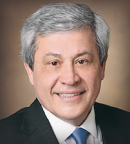Use of the first investigational oral selective estrogen receptor degrader (SERD) elacestrant significantly reduced the risk of death or disease progression and lengthened progression-free survival compared with standard-of-care endocrine therapy with fulvestrant or an aromatase inhibitor in postmenopausal women with estrogen receptor–positive/HER2-negative metastatic breast tumors that progressed on prior endocrine and targeted therapies. Reduction in the risk of death or disease progression was more pronounced in a subgroup of patients with ESR1-mutated tumors, according to the results of the phase III EMERALD trial presented at the 2021 San Antonio Breast Cancer Symposium (SABCS).1 EMERALD is the first phase III clinical trial to study an oral SERD.
“There is an urgent unmet need for alternate SERDs that are effective against estrogen receptor–positive metastatic breast cancer, including those with ESR1 mutations [associated with endocrine resistance],” said primary author and principal investigator Aditya Bardia, MD, MPH, Director, Breast Cancer Research at Massachusetts General Cancer Center and Associate Professor of Medicine at Harvard Medical School.

Elacestrant is the first oral SERD to demonstrate an improvement in progression-free survival in a randomized, global, phase III study.— Aditya Bardia, MD, MPH
Tweet this quote
“Elacestrant is the first oral SERD to demonstrate an improvement in progression-free survival in a randomized, global, phase III study. The study included patients with estrogen receptor–positive/HER2-negative metastatic breast cancer in the second- and third-line settings, including those whose tumors harbor ESR1 mutations,” Dr. Bardia said. “Elecastrant was overall well tolerated with manageable and reversible side effects, and it has the potential to become the new therapeutic option in the studied population.”
By contrast with intramuscular fulvestrant, the only approved SERD for patients with breast cancer, elacestrant is administered orally. Studies suggest that elacestrant has greater absorption, improved pharmacokinetics, and enhanced estrogen receptor inhibition compared with fulvestrant. Studies in mouse models with xenografts of estrogen receptor–positive breast cancer showed greater antitumor activity with elacestrant vs fulvestrant, Dr. Bardia noted. A phase I clinical trial showed acceptable safety and encouraging responses to elacestrant in heavily pretreated, postmenopausal patients with estrogen receptor–positive/HER2-negative metastatic breast cancer.2
Endocrine therapy plus a cyclin-dependent kinase 4/6 (CDK4/6) inhibitor is the mainstay of first-line treatment for estrogen receptor–positive advanced breast cancer. However, most patients with estrogen receptor–positive metastatic breast cancer develop resistance, including ESR1 mutations. After treatment with a CDK4/6 inhibitor, single-agent fulvestrant is associated with a median progression-free survival of approximately 2 months.3 Thus, there is a need for better endocrine therapy for patients with estrogen receptor–positive/HER2-negative metastatic breast cancer.
Study Details
The multicenter, international, randomized, open-label phase III EMERALD trial enrolled 477 postmenopausal women with estrogen receptor–positive/HER2-negative metastatic breast cancer. They had been treated with one or two prior lines of endocrine therapy without chemotherapy for metastatic disease and had experienced disease progression on prior treatment with a CDK4/6 inhibitor.
Patients were randomly assigned 1:1 to receive either elacestrant or the standard of care (investigator’s choice of fulvestrant or an aromatase inhibitor, including anastrozole, letrozole, or exemestane). Among 477 participants, 228 had tumors with mutated ESR1 evenly distributed between both treatment arms (115 in the elacestrant arm and 113 in the standard-of-care arm).
Demographic and disease characteristics were similar across both treatment arms. The median age of patients was around 63 years; about 43% had received two prior lines of therapy; 100% of patients in both arms had experienced disease progression on a CDK4/6 inhibitor.
Key Findings
The study met both primary endpoints of improved progression-free survival in the overall study population and in the subgroup with ESR1 mutations. Among all patients, those randomly assigned to receive elacestrant had a 30% reduction in the risk of disease progression or death vs the standard of care (P = .0018). Among those with ESR1 mutations, elacestrant achieved a 45% reduction in the risk of disease progression or death vs the standard of care (P = .0005).
“All subgroups achieved a benefit with elacestrant vs standard-of-care endocrine therapy, including those treated with fulvestrant,” Dr. Bardia noted.
Elacestrant was superior to the standard of care for key secondary endpoints, including visceral metastases, number of prior lines of therapy, and geographic region.
The 12-month rate of progression-free survival was 22.3% with elacestrant vs 9.4% with the standard of care for all patients; the corresponding rate was 26.8% vs 8.2% for those with mutated ESR1. A prespecified interim analysis of overall survival demonstrated a numerical trend favoring elacestrant over the standard of care, including in the ESR1-mutated subgroup. The final overall survival analysis is expected later this year.
Toxicity
Treatment-emergent adverse events that were more common with elacestrant compared with the standard of care included nausea, vomiting, and fatigue. All-grade nausea was reported in 35% of the elacestrant group vs 18% of the standard-of-care arm. Grade 3 or 4 nausea occurred in 2.5% of elacestrant-treated patients. The rate of grade 3 or higher treatment-related adverse events was twice as high with elacestrant: 7.2% vs 3.1%, respectively. No treatment-related deaths were reported in either arm.
“Patients did not discontinue treatment with elacestrant because of nausea, and rate of discontinuation due to toxicity was generally low in both arms,” Dr. Bardia commented.
Future Studies
According to Dr. Bardia, one limitation of the study is that all participants received prior treatment with a CDK4/6 inhibitor. Thus, the efficacy of elacestrant in patients without prior CDK4/6 inhibition is unknown. Future studies are planned to explore elacestrant earlier during treatment and in combination with other therapies. Currently, a phase II trial is planned to explore the combination of elacestrant plus abemaciclib in patients with brain metastases and with mTOR inhibitors as well as PI3K inhibitors.
Additional Commentary

The results of EMERALD suggest this new SERD [elacestrant] may become a new treatment option, not only as single therapy but also in combination with other targeted therapies.— Carlos L. Arteaga, MD
Tweet this quote
Carolos L. Arteaga, MD, commented on the results of the EMERALD trial during a press conference at the SABCS: “This is an important study of the first SERD other than fulvestrant in patients who experience disease progression on a CDK4/6 inhibitor. This is clearly an unmet need. The results of EMERALD suggest this new SERD may become a new treatment option, not only as single therapy but also in combination with other targeted therapies.”
Dr. Arteaga is Past President of the American Association for Cancer Research (AACR; 2014–2015), Director of the Harold C. Simmons Comprehensive Cancer Center, and Lisa K. Simmons Distinguished Chair at UT Southwestern Medical Center, Dallas.
DISCLOSURE: The EMERALD trial was funded by Radius Health. Dr. Bardia has served as a consultant or advisor to Genentech/Roche, Immunomedics/Gilead, Novartis, Pfizer, Merck, Radius Health/Menarini, Foundation Medicine, Sanofi, AstraZeneca, Daiichi Sankyo, and Eli Lilly; and has received institutional research funding from Genentech, Novartis, Pfizer, Merck, Sanofi, Radius Health, Immunomedics/Gilead, Daiichi Sankyo/AstraZeneca, Eli Lilly, and Natera. Dr. Arteaga has served in a leadership role for the AACR; holds minor stock options in Provista Diagnostics; serves or has served as a scientific advisor to Daiichi Sankyo, AstraZeneca, Immunomedics, Lilly, Merck, Novartis, OrigiMed, Sanofi, and Taiho Oncology; receives research funding from Lilly, Pfizer, and Takeda; and serves on the scientific advisory board of the Susan G. Komen for the Cure Foundation.
REFERENCE
1. Bardia A, Neven P, Streich G, et al: Elacestrant, an oral selective estrogen receptor degrader vs investigator’s choice of endocrine monotherapy for ER+/HER2– advanced/metastatic breast cancer following progression on prior endocrine and CDK4/6 inhibitor therapy: Results of EMERALD phase 3 trial. 2021 San Antonio Breast Cancer Symposium. Abstract GS2-02. Presented December 8, 2021.
2. Bardia A, Kaklamani V, Wilks S et al: Phase I study of elacestrant (RAD1901), a novel selective estrogen receptor degrader, in ER-positive, HER2-negative advanced breast cancer. J Clin Oncol 39:1360-1370, 2021.
3. Lindeman GJ, Bowen R, Jerzak JK, et al: Results from VERONICA: A randomized, phase II study of second-/third-line venetoclax + fulvestrant vs fulvestrant alone in ER-positive, HER2-negative, locally advanced, or metastatic breast cancer. J Clin Oncol 39 (suppl 15):Abstract 1004, 2021.

